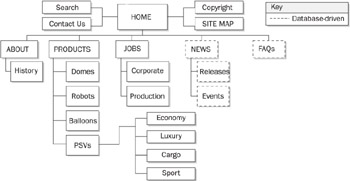The Site Plan
| < Day Day Up > |
Once a goal, audience, and site requirements have been discussed and documented, a formal site plan should be drawn up. The site plan should contain the following sections:
-
Short goal statement This section contains a brief discussion to explain the overall purpose of the site and its basic success measurements.
-
Detailed goal discussion This section discusses the site's goals in detail and provides measurable goals to verify the benefit of the site.
-
Audience discussion This section profiles the users who would visit the site. The section would describe both audience characteristics as well as the tasks the audience would try to accomplish at the site.
-
Usage discussion This section discusses the various task/visit scenarios for the site's users. Start first with how the user arrives at the site and then follow the visit to its conclusion. This section may also include a discussion of usage measurements, such as number of downloads, page accesses per visit, forms being filled out, and so on as they relate to the detailed goal discussion.
-
Content requirements The content requirements section provides a laundry list of all text, images, and other media required in the site. A matrix showing the required content, form, existence, and potential owner or creator is useful, as it shows how much content may be outstanding. A simple matrix is shown in Table 2-1.
Table 2-1: Content Matrix Content Item
Description
Content Type
Content Format
Exists?
Owner
Butler Robot Press Release
Press release for new Butler 7 series robot that ran in Robots Today
Text
Microsoft Word
Yes
Jennifer Tuggle
Software Agreement Form
Brief description of legal liability of using trial robot personality software
Text
Paper
Yes
John P. Lawyer
Handheld Supercomputer Screen Shot
Picture of the new Demo Company Cray-9000 handheld palm size computer
Image
GIF
No
Pascal Wirth
Welcome from President Message
Brief introduction letter from President to welcome user to site
Text
Microsoft Word
No
President's Executive Assistant
-
Technical requirements This section provides an overview of the types of technology the site will employ , such as HTML, XHTML, CSS, JavaScript, CGI, Java, plug-ins, and so on. It should cover any technical constraints such as performance requirements, security requirements, multidevice or multiplatform considerations, and any other technical requirements that are related to the visitor's capabilities.
-
Visual requirements The visual requirements section outlines basic considerations for interface design. The section should indicate in broad strokes how the site should relate to any existing marketing materials and provide an indication of user constraints for graphics and multimedia, such as screen size, color depth, bandwidth, and so on. The section may outline some specifics, such as organizational logo usage limitations, fonts required, or color use; however, many of the details of the site's visuals will be determined later in the development process.
-
Delivery requirements This section indicates the delivery requirements, particularly any hosting considerations. A basic discussion of how many users will visit the site, how many pages will be consumed on a typical day, and the size of a typical page should be included in this section. Even if these are just guesses, it is possible to provide a brief analysis of the server hardware, software, and bandwidth required to deliver the site.
-
Miscellaneous requirements Other requirements may need to be detailed in the site plan, such as language requirements, legal issues, industry standards, and other similar considerations. They may not necessarily require their own separate discussion, but instead may be addressed throughout the other sections of the document.
-
Site structure diagram This section provides a site structure or flow diagram detailing the various sections within a site. Appropriate labels for sections and general ideas for each section should be developed based on the various user scenarios explored in earlier project phases. Organization of the various sections of the site is important and may have to be refined over time. Often, a site diagram will look something like the one shown in Figure 2-2.

Figure 2-2: Typical site organization diagram -
Staffing This section details the resources required to execute the site. Measurements can be in simple man-hours and should relate to each of the four staffing areas: content, technology, visual design, and management.
-
Time line The time line should show how the project would proceed using the staffing estimates from the preceding section combined with the steps in the process model outlined earlier in the chapter.
-
Budget A budget is primarily determined from the staffing requirements and the delivery requirements. However, marketing costs or other issues such as content licensing could affect the site cost as well.
This is just a suggested site plan ”the actual organization and content of a site plan is up to the developer. However, don't skip writing the plan even though it may seem daunting. Without such a document, you can only develop a project in an evolutionary fashion (almost trial-and-error manner), which may result in many false starts and waste time and money. Furthermore, it will be nearly impossible to obtain any realistic bids from outside vendors on a Web site without a detailed specification.
A finished plan doesn't allow you to immediately proceed to implementation. Once the specification is developed, it should be questioned one last time, preferably by a colleague or someone with an outside perspective. The completed specification may reveal unrealistic estimates that will throw you back to the stage of questioning initial goals or audience. If it survives, it may be time to actually continue the process with the design and prototyping stage.
| < Day Day Up > |
EAN: 2147483647
Pages: 252